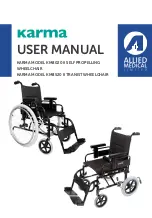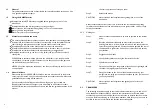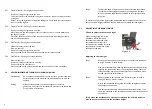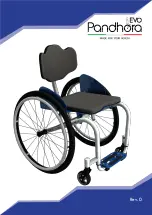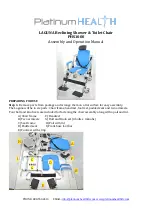
A
Flip-back, heigh-adjustable armrest with desk-length arm pad
B
Push-to-lock brakes
C
70-degree legrests with calf strap
D
Plastic footplate
E
Height-adjustable backrest
F
Quick release, removable rear wheels
G
Anti-tippers
H
8” x 1” solid castor
I
Transit rear wheel
J
Rubber grip handles
SPECIFICATIONS
14”, 16”, 17” 18”, 20”, 22”
16”, 18”
Options:
1” and 2” (+/-)
customisation for 14”-
20” width frames
Transit 12.5”
Self Propel 24”
Options
: 22” x 20”
8” x 1” solid
Options:
8” x 2” pneumatic
6” x 1” solid or pneumatic
Self Propel:
Seat width + 9”
Transit: Seat width + 6”
8.5” min
11.5” max
15.5”
Options:
18.5” with
upholstery extension
22” with extended back
canes
19”
Options:
Customised
configurations 16” - 21”
32” (42” with 70-deg
hangers)
35”
Options:
38” with 22”
back canes
Transit 13.5 kg
Self Propel 15.5 kg
(With all standard features)
14”-18” width frames
130 kg
20”-22” width frames
160 kg
Seat width
Seat depth
Rear wheel
Front castor
Seat to floor
height
Back height
Armrest height
Overall width
(when open)
Overall length
Overall height
User weight limit
Wheelchair weight
1.1
General
Only maintenance and service as described in this manual should be carried out. Use
only genuine replacement parts.
1.2
Using the KM8020 series
Always make sure BOTH brakes are applied before getting into or out of the
wheelchair.
Always take care when climbing kerbs or turning on slopes.
Never stand on the footplates when getting in or out of the wheelchair.
Never go down steps forward.
Never carry more than one passenger.
1.3
Notes for attendants and users
Do ensure that the brakes are always on when the wheelchair is not being pushed.
Always make sure that both of the user's feet are safely on the footplates and that
their clothing is safely tucked out of the way and cannot catch in the wheel.
Always keep both hands on the push handles to control the wheelchair.
Always look well ahead to anticipate hazards such as furniture, doors or potholes.
Always avoid soft surfaces because the wheelchair may get bogged down.
Always be careful not to go too fast or turn quickly and try to achieve a smooth
steady ride.
PLEASE keep in contact with the person in the wheelchair. If you stop to look in
shop windows or talk to people remember to turn the chair so that the person in
the wheelchair does not have to turn.
NEVER put on the brakes too suddenly or too firmly as this may tip the user out of
the wheelchair.
1.4
General Misuse
Please note that our USER GUIDE contains a number of cautions. Any vehicle can
cause injury if misused. Use your wheelchair with reasonable care and within these
guidelines and your safety will be ensured.
If used sensibly and carefully, your wheelchair will give you years of safe use.
Be aware that careless use endangers your own safety as well as that of others.
ALWAYS follow the road code when outdoors and also the guidelines written in this
manual.
Page 1
Page 14
Brake Clamp
Transit Axle Block
Position
Figure 3.7.3
Figure 3.8.1
Figure 3.8.2
Figure 3.8.3
Standard
Fr
on
t o
f C
ha
ir
Antitipper
Wheel mounting
Bracket
M5 Nut and Bolt
Amputee
Wheel mounting
Bracket - Standard
Mount
Step 3: Use the larger bottom hole on
the block (see fig 3.3.3) to mount
the transit wheel. The block
should be pointing towards the
ground with the flat side of the
block facing outwards away from
the frame.
3.8
CHANGING FROM STANDARD CONFIGURATION TO AMPUTEE
SETTING
Step 1: Remove hangers, quick-release
wheels and axles. Place
wheelchair on bench/table or
floor as shown in figure 3.8.1.
Step 2: Remove the two M6 nuts and
bolts with a 5mm allen key and
10mm spanner (as supplied in
Karma tool kit).
Step 3: Reposition wheel mounting
bracket as required. Replace
bolts, washers and nuts and
tighten. Replace quick-release
wheels, loosen brake clamps with
a 5mm allen key and slide along
frame to suit new wheel position.
HANDY HINT: Work on one side at a time so the other side can be used as
reference for correct brake positioning.
NOTE:
If changing from amputee setting back to standard configuration
move the brake before replacing the quick-release wheels.
the user can place their feet upon them.
Step 5:
Release the brakes.
CAUTION:
Never stand on the footplates when getting into or out of the
wheelchair.
Always ensure that the front castors are in line with the rear wheels and pointing
forwards and that the back of the wheelchair is secure against either a wall or firmly
held by an attendant.
2.2.2
Getting out
Step 1:
Make sure that the wheelchair is as close as possible to the transfer
point.
Step 2:
Back the wheelchair sufficiently to ensure that the castors are
pointing forward i.e. in line with the rear wheels and usually with the
castor forks pointing forward. Ensure that where possible the rear of
the wheelchair is against the wall or, if not, it must be firmly held by
an attendant.
Step 3:
Engage both the brakes.
Step 4:
Lift up the footplates and swing the footrests to the side.
Step 5:
Slide forwards on the seat.
Step 6:
Place one foot firmly on the ground with the knee at right angle and
the other foot slightly apart and further back.
Step 7:
Place your hands on the front of the armrests and moving your
weight forward, bring your head and shoulders up over your knees as
you push yourself up.
CAUTION:
Never stand on the footplate when getting out of or into the
wheelchair.
2.3
TRANSFERS
The following instructions apply to users with sufficient mobility to get in and out of
the wheelchair without assistance. However the instructions are still valid where
assistance is required and will help where other aids such as transfer boards or hoists
are used. Before transferring to or from the wheelchair, make sure you are as near as
possible to your point of transfer and that the brakes are applied.
Page 4
Page 11
2
3

